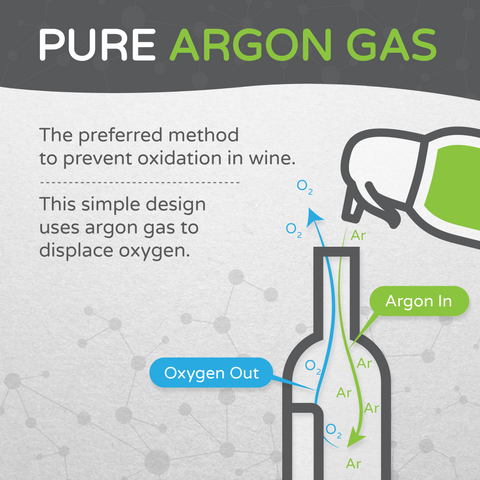How to Keep Wine Fresh
Oxygen attacks your wine as soon as you open your bottle. In the short term, it opens up the flavors and aromas. But as soon as a few hours after opening, oxidation starts to degrade your wine. Wine spoils in as quickly as 24 hours and most wine spoils as quickly as 3 days later.
ArT Wine Preserver® preserves your wine with pure argon.

What does the oxygen do?
Oxygen is found in the air and allows us to breath. However, it also oxidizes foods like chips and causes brown spots on your apples and avocados. This same process degrades your wine as soon as you open the bottle.


Oxidation causes your fruits to turn brown and degrades your wine.
What does the argon in ArT Wine Preserver® do?
Argon is another gas found in our atmosphere (~1% of the air we normally breath). It is a non-toxic and non-reactive gas that is denser than air (by a factor of about 1.4). It acts as a non-reactive barrier between your wine, your wine's aromas, and the attacking oxygen.
High end applications, such as nice bottles of wine, will use this same gas to displace oxygen when bottling at the winery. ArT Wine Preserver has a patent pending on the dose of argon used to create a layer of argon protecting the wine. We let you put genie back into the bottle!
Directions
On first use, remove the tamper tab on the product.
1) Enjoy your wine: Open the bottle, pour as much or little as you want.
2) Apply a 2 second dose of ArT Wine Preserver to the open bottle. This patent pending dose preserves your wine no matter how much is left.
3) Reseal your wine bottle. Any wine stopper will do, we supply one ArT Wine Stopper per order.
Is it safe?
Argon is a non-toxic chemical that is FDA G.R.A.S. (Generally Recognized As Safe).
Don't take our word for it. Check out what over 100 reviews on Amazon have to say.
4 Free Ways to Keep Wine Fresh
There are some ways to decrease oxidation that can help keep wine fresh and can be combined with the ArT Wine Preserver for maximum effect.
1) Refrigerate
Basic refrigeration, even on your reds, will slow down the oxidation process. For maximum preservation - we recommend this to our customers even with the ArT Wine Preserver (to hit the full 30 day maximum).
2) Remove Sunlight
Keeping your wine away from sunlight will minimize adverse reactions caused by the light, and any heat.
3) Prevent Vibration
Unnecessary vibrations should be avoided to make an open bottle of wine last longer. By "vibrations" - we aren't talking about a little hum in the fridge. We mean shaking or transporting an opened bottle of wine in the back of pickup truck. This basically aerates a wine, because it makes for more collisions between the oxygen and the wine. Aeration is a good thing right before consumption, as it brings out the aromas and flavors. But aeration earlier will lead to degradation.
4) Store Upright
Leaving the bottle upright decreases the surface area exposed to oxygen compared to laying down. Lower surface area decreases the amount of molecular collisions between the wine and oxygen and therefore the rate of the oxidation reaction.
This may seem counter intuitive since unopened wine bottles are typically stored on their side. Keep in mind we are currently discussing already opened bottles of wine. In which case a reusable cork with argon is the absolute best method of “sealing”, as it reduces the surface area exposed to oxygen even after pouring.
These free methods can help keep wine fresh for 1 to 3 days, combine with ArT Wine Preserver® to keep wine fresh for 7 to 30 days.
Need more wine basics? Check out our Wine Guide below!


